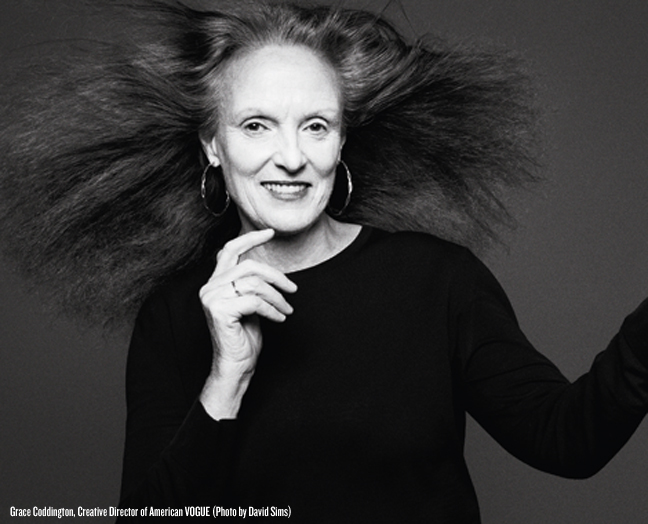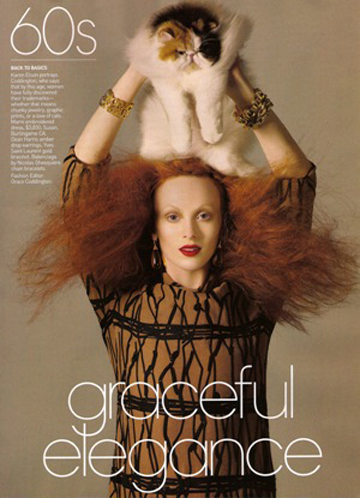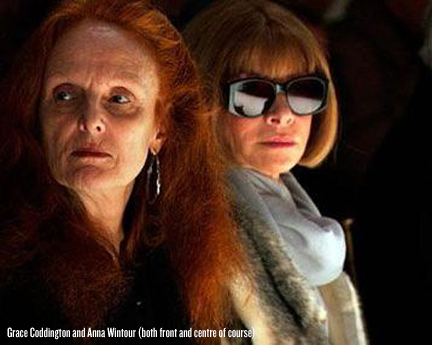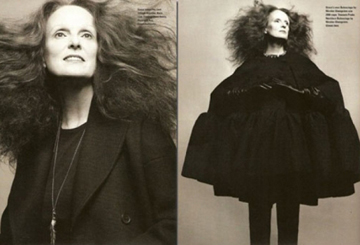First publised in More Intelligent Life (Winter 2010) by Julie Kavanaugh..☛..On a summer night in New York one of the gays in a huddle outside Rawhide on Eighth Avenue calls out, “We love you, Grace!” as she walks home. In Paris, at the autumn ready-to-wear shows, a giggling Japanese girl asks if she can be snapped next to her. Grace Coddington, the creative director of American Vogue, who turns 70 in April, has been a quietly revolutionary presence in the fashion world—first as a model, then as an editor—for half a century. But only since the release of the film “The September Issue” in 2009 has she been recognised in public—greeted by strangers who witnessed some of her creative battles and now see her as a reassuringly human face of fashion.
The object of the documentary, which recorded Vogue’s most commercial edition taking shape, had been to spotlight its editor-in-chief Anna Wintour. But an unexpected narrative began to emerge in the daily tug-of-war between Wintour and Coddington—one demanding a legible display of wearable, contemporary fashion, the other drawn to images that are poetic, quirky or historical; Wintour embracing the cult of celebrity, Coddington resisting its edicts and undermining of editorial freedom. Exasperated by the prospect of eight months of fly-on-the-wall intrusion, Coddington at first refused to co-operate, but ended up forging a mischievous complicity with the camera. With her inimitable hennaed mane and stomp-stomp warpath walk, she stole the film.
I wasn’t surprised. I first met Grace Coddington in the spring of 1972, when I was 19 and had just been fired by my exacting boss, the beauty editor of British Vogue. As I began posting off panicky job applications, the editor-in-chief, Beatrix Miller, summoned me and said that one of the fashion editors wanted me to work for her. Dressed in those days in a smart Albini suit, little hat and Saint Laurent heels, Coddington was considered terrifying by the other assistants. (The late Liz Tilberis, who went on to edit Harper’s Bazaar, described her as “elusive, severe, silent”.) But having set my sights on what I saw as serious journalism, I had barely registered who Grace was. “The fashion department is the one place I’ve always vowed to stay clear of,” I wrote to my mother in Cape Town. “The job would only be dogsbody work with no chance whatever to write.” Alone in London, with rent to pay, I was in no position to turn down a salary—even one of £800 a year—and so I moved across the corridor into the fashion room, joining the four other editors and their assistants. Jolly, freckly Liz Tilberis, a turbine of energy, modestly attributed her early success in fashion to knowing “how to do really, really good ironing”. I scorched the first garment in my care (after which Grace ironed everything herself), and was a pretty useless, unmotivated apprentice: so why, I asked her recently, did she rescue me? “I’d noticed you,” she told me. “But it must have been because of Barry.”
Barry Lategan—a gentle, intense South African photographer, whose portrait of a Cockney waif wrapped in a black studio curtain had launched Twiggy as the Face of ’66—was a friend of my mother’s, and of Grace’s. They met in the mid-1960s when Barry, charmed by Grace’s “singular look and her independence”, took a modelling shot of her; by 1968, when she married the restaurateur Michael Chow at Chelsea Registry Office, Barry and his girlfriend were the witnesses and only guests. “The four of us went to a very expensive restaurant for lunch, and then Barry did the wedding pictures with Michael standing next to me on a camera case to give him height.” At the same time, Grace made the transition from modelling to working for Vogue. As the editor in charge of covers and photographs for the beauty pages, she began to collaborate regularly with Barry, who specialised in studied, painterly portraits. Grace describes the result as “very worked on and accessorised: Barry gave you a situation where you had a canvas to paint.” He, in turn, felt liberated by her instinctive openness to offbeat ideas. “When you put something to other editors, they’d ask ‘Why?’ But Grace would say, ‘Why not?’ ”
Most of our sittings were with Barry. She would arrive at his studio in Flood Street, Chelsea, in her black Mini, and I would help unload armfuls of shirts, hats and jewellery for the day. We did an “amber story” on the actress and model Ingrid Boulting, whom Grace festooned with Butler & Wilson bakelite beads and bangles, offsetting her neat chignon with a funny little crocheted hat of a bird in a nest. The French model Mouche was transformed into a woodland sprite in a rosy top and cobwebby petal hat by a pair of Argentine designers, Pablo and Delia, who mixed commedia dell’arte imagery with English chintz and idiosyncratic touches like a necklace of leather cherries, or a silver choker hung with thongs and white feathers. The sessions took place in Barry’s tranquil, panelled studio, with its scent of sandalwood and Mozart playing faintly in the background. We’d linger over lunch, usually salads and flans ordered from Robert Carrier’s shop, and Barry would talk earnestly about a new play or exhibition he’d seen.
.
“Everything was so perfect,” says Grace. “And Barry’s pictures were like that—absolutely still and perfect. We’d take a whole day to do just one, and then we’d go for dinner at San Lorenzo, or Barry would cook. His friends were my friends. [David] Bailey never wanted people around, and resented fashion editors—he was almost fucking the girls with his camera. But Barry wanted a team around him, helping to make things perfect.”
.
There were always two other key players: a hairstylist from the Leonard salon— either John Frieda, Celine or Oliver—and the make-up artist Barbara Daly. The creator of the cultish look for “A Clockwork Orange”, and later largely responsible for turning the ruddy-cheeked Sloane Ranger Diana Spencer into a legendary beauty, Barbara was someone else brought to Grace by Barry. Although the concept of working with a leading hair-and-make-up person was new to her, she welcomed the collaboration. “Before, models did their own make-up, or a rep from one of the cosmetic houses would come along. But we were a team and I was part of that.” A gallery of the team’s highly stylised portraits can be seen today downstairs in the London salon of Daniel Galvin (another Leonard protégé). Grace herself is there, looking like a 1940s film star, alongside a pierrot-faced model in profile with navy-blue shadowed eyelid, brow and cheekbone, a nude cloaked with rainbow-dyed hair to her knees, and a back view of a feathered head with a lit sparkler as a topknot. It was the beauty pages that licensed this kind of innovation in Vogue, which was still mostly given over to Ascot outfits, mackintoshes, twills and tweeds. The editor who catered for the dowager readership was Sheila Whetton, a Molyneux model from the 1930s, so immaculately groomed that not even her startlingly incongruous expletives could sully the effect. “I was really inspired by Sheila,” Grace says. “It wasn’t so much that I liked the clothes she shot, it was her intense love of fashion, her dedication and attitude to life.”
Grace established what the New York gallery-owner James Danziger has called “her own Camelot” of images, making astonishing leaps of imagination each month. She would contrast a brisk iconoclasm—as in the shot of a flame-haired, Grace-ish model in satin hotpants, scarlet tights and platform heels racing an old-fashioned pram past elderly Norland nannies in Hyde Park—with nostalgic, classic pictures. I was with her when Cecil Beaton photographed the Japanese model Tina Chow in antique cheongsams from her collection. Grace had imagined her looking like Anna May Wong reclining on a chaise longue and framed by a pleiad of paper parasols, but Beaton had ideas of his own. “He was pretty old by then, and I was very much in awe of him. But what was frustrating was that he was trying to be modern—he’d just worked with Veruschka—and I wanted the kind of pictures he used to do.” She got her way by surreptitiously involving Beaton in the arrangement of the props. “I tried to think of something dear to his heart,” she says, “and I knew he loved gardens. So I got him through the flowers!” Then there were the shoots she did “for fun”. For a cover, she got David Bailey to shoot the actress Anjelica Huston enfolded in the arms of the shoe designer Manolo Blahnik, in a kitschy pose against a Corsican coastal sunset. Grace bursts out laughing when I remind her. “It was pretty ridiculous—there’s no one more camp than Manolo. He brought his own clothes and took far more of my time discussing what he was going to wear than Anjelica did. To shut him up we buried him in the sand, with only his head and spotted handkerchief showing.”
Working for Grace converted me to fashion overnight. With my hair permed and hennaed into a pre-Raphaelite haze I became her mini-clone, wearing shirts knotted at the midriff, and vintage dresses with character shoes and stockings, never tights. It wasn’t the copycat infectiousness of fashion, or any obligation to conform—it was simply the power of Grace’s personality and style. “Fashion isn’t just frocks,” she has always maintained. “It’s how we do our houses, our gardens, it’s what we eat and drink.” Her influence stays with me to this day, whether it’s painting my bathroom floorboards a glossy ebony, hanging a rusty chandelier or reproducing her distinctive oriental take on hamburgers.
Almost all Grace’s close friends are ex-assistants. According to one, Di James: “You felt you worked with her rather than for her. She can be steely and as stubborn as hell, but there is that vulnerable side which adds to her charm.” We all knew she cared about us. “If I get to like them,” she says, “there’s nowhere I wouldn’t go to help them along.” At Vogue, our headmistressy editor-in-chief, Beatrix Miller, had dismissed my ambition to write, and so I’ve always assumed that Grace had a hand in what happened next. After several months of striving to produce lively fashion copy for her pages, I was given my first real break: the chance to join her on a trip to Portugal, not as an assistant, but as the travel writer. The photographer was Norman Parkinson—Grace’s own mentor. At six foot five with a curling white moustache, he was like a caricature of a colonial Englishman. To Alexander Liberman, Condé Nast’s charismatic art director, Parkinson was “an arch snob and a phoney”, but Grace was smitten. “Parks was the father anyone would want to have. An extraordinary man—charming, clever, funny. I loved the way he’d never take a picture without wearing his lucky Kashmiri wedding hat. He lived in Tobago and was very well-travelled, whereas I’d hardly been anywhere.” Grace’s first trip with Parkinson, to the Seychelles in 1971, had been an epiphany. Together they began to create the fashion narratives that became her trademark—fantasy travelogues conveying the essence of a place.
“He taught me the art of travelling, which means never closing your eyes in case you miss something. We’d get up at five and drive round on recces to see what inspired us. The approach is so different now. Photographers don’t look out the window: they want to see a location book, and everything is done on computers.”
As if she had already imagined the old Portuguese women shading themselves with city umbrellas on their way to market, the clothes Grace brought with us were all black. Mouche, our model, wore Gina Fratini cobble-brushing jersey dresses with capes and frills, hats over headscarves, a leotard with a long, tiered skirt to ride side-saddle—the effect vividly offset by the Algarve’s marine and palomino colours. I went off on my own in a hired car, and in the evenings we’d all meet up in a fishing village and eat sardines, caught that day and grilled over an open fire. “I can still taste them today,” Grace says, “oily and burnt.” In October 1973 she took me to the Paris ready-to-wear shows for the first time. We ordered Sancerre by the glass at the Café de Flore and gorged on langoustines at La Coupole. Grace knew Paris well, as—before, during and after her marriage to Michael Chow—she had been in love with a young Vietnamese photographer, based in Paris, who took her to the cheap Left Bank restaurants. At her favourite, Long Hiep, we always had the same thing—pho ga, a chicken noodle broth grassed with fresh coriander leaves, and prawn spring rolls parcelled with mint and lettuce, and dipped in sweet peanut sauce.
I remember the food that autumn better than the fashion. “I’ve never seen so many women in one square of smoke, noise, heat, lights,” I told my mother, adding that Grace and I were sharing a maid’s room in the eaves of the Ritz. The following year, we worked on a Helmut Newton shoot in Paris, featuring silk tea-gowns and lacy gloves designed for Chloé by Karl Lagerfeld, who had just begun to make his name. I was an extra in the picture, dressed as a French maid, and Karl, whose apartment we were in, sat on the side sketching us, a swarthy, bearded, jovial presence. This was to be my last assignment: I left Vogue soon afterwards to join the American magazines Women’s Wear Daily and W. I suspect one thing that persuaded the editor, the urbane John Fairchild, that he could risk employing a 21-year-old as his London editor was seeing how much I had absorbed in 18 months working for Grace.
Paris, March 2010. A coterie of friends and press VIPs, including Grace and Jonathan Newhouse, the chairman of Condé Nast International, are trying and failing to reach Karl Lagerfeld after his Chanel ready-to-wear collection at the Grand Palais. A massive bodyguard bars the way backstage, while on the catwalk, the show’s coup de theatre, a 265-tonne iceberg, melts before our eyes. Chanel’s PR is powerless and distraught. It takes Lagerfeld’s diminutive creative assistant Amanda Harlech, in black beehive, high court shoes and a compact fury, to get us past and into the hangar of a dressing room. At the back is a screened-off area, policed by yet more guards, where Grace finally air-kisses and congratulates Lagerfeld. Spotlit, miked and surrounded by the world’s cameras, the gentle German of 1974 has become Kaiser Karl—unreachable and invincible, his security entourage as much part of the image as his concave cheeks, blackout shades and shining white ponytail.
“Karl plays the celebrity game,” says Grace, recalling how she once saw him being mobbed at Grand Central Station in New York; instead of trying to escape, he had done an extra circuit of the concourse. “I always make this mistake and think it must be really unpleasant for him, but he actually enjoys it—it’s very rock ’n’ roll.”
At the Yves Saint Laurent show little has changed since the mid-1970s. The front-row hierarchy still includes three of Saint Laurent’s original muses—Lulu de la Falaise, Betty Catroux and Catherine Deneuve—all recognisable, if pretty raddled, the now matronly Deneuve raising a wry eyebrow at a passing chiffon number worn over a black thong. The difference is that Grace is now as much the cynosure as they ever were. A blitzkrieg of flashbulbs greets her entrance at every show, a nod of “Allez-y” allowing her through barriers before she has even found her invitation. Her Paris today is far grander—a large room at the Ritz, a chauffeur on hand, Caviar Kaspia a favourite restaurant—and yet it’s an unenviable routine.
The day I arrived, Grace had left Paris at 5am for a Prada appointment in Milan, and got back only just in time for Saint Laurent. Her driver, the suave, cultured Jean-Louis, is at her disposal, but the collection-week gridlock tests the steeliest nerves, and time and again Grace was miserably stressed. Valentino held the show until she arrived, almost an hour late, and she was booed by the photographers as she crossed the catwalk to her seat. She was late because she had stayed on after Alexander McQueen’s posthumous collection to talk to the sobbing seamstresses and staff. “How could I rush away?”
After the shows are the “re-sees”, booked relentlessly one after the other, and lately it has become too much for her. “I got really sick last time in Paris, and I was on antibiotics for two months. I push my body too hard, and do have to stop myself now from jumping on a plane. It used to be me who got sent to Russia and China while the older editors like Sheila Whetton stayed behind: but I’m one of those older ones now.” Up to a point. When I spoke to her in January, it was business as usual. “Shooting this weekend and next week and the following weekend. Then it’s the New York collections, then la with Bruce [Weber], then Paris, and now Anna’s trying to get me to go to China…” So much for scaling back.
GRACE CODDINGTON: A LIFE IN BRIEF
1959: At 18, Grace leaves home in Anglesey, Wales, and enrols in Cherry Marshall’s modelling school in London. Norman Parkinson takes his first shots of her, at his farm in the country. “I was running naked through a wood, but it didn’t bother me. Wenda, his wife, was there, and Parks was so charming and dapper.” She wins Vogue’s Young Model competition the same year. “Ah-ha,” says Parkinson at the prize-giving tea, “you made it here! You’ll do well.”
1961: A car accident smashes her face into the driving mirror and slices off an eyelid. She endures two years of plastic surgery before returning to modelling.
1968: After six years of displaying a tendency to take over on shoots and tell stylists how to style, Grace joins British Vogue as a junior fashion editor, on a salary of £1,100 p.a. This is a quarter of what she earned as a model, but she feels it is time to move on. “All the young models come along and make you feel old standing beside them. And styling seemed like a fun, easy job—until I did it.”
1969: She marries Michael Chow at Chelsea Registry Office. Her new husband is the young, entrepreneurial owner of one of the restaurants of the moment, Mr Chow in Knightsbridge. “The restaurant was buzzing with amazing people. It was so much fun,” she says. ”But I was useless at being a restaurateur’s wife—much too shy to table-hop.” They split up after six months.
1973: Grace meets a photographer, Willie Christie, a rangy, rock’n’roll figure, and mentors him at Vogue. The same year, her sister, Rosemary, dies suddenly. Her nephew, Tristan, spends summer holidays with her and Willie at their home in Fulham: “Willie loved kids and took Tristan into the family.” But when they try to adopt him, the authorities refuse. “It was hardly surprising.”
1976: Willie and Grace marry, but “it’s difficult to be employed by your wife,” she says, and they divorce in 1980. Grace transforms herself into a business-suited, short-haired blonde—what she calls a “Calvin person”.
1980-86: At British Vogue, Grace creates a startling series of “sprawling, National Geographic-style photo essays—more than 20 pages long—in which the clothes were so smoothly integrated they barely registered as fashion photographs at all”, as the fashion writer Michael Roberts put it. In March 1986, Anna Wintour becomes editor-in-chief. Grace resigns in December: “Anna was much more into ‘sexy’ than I was.”
1987: A few months later, Grace takes a new job as design director for Calvin Klein in New York—mostly, she says, so she can spend more time with the French hairstylist Didier Malige, a long-time collaborator of hers, who was based in America. She still lives with him today.
1988: She rejoins Anna Wintour, who has now taken up the reins at American Vogue, because she misses the creative buzz of magazines. “Excitement on 7th Avenue ends with the show. The next day it’s all marketing.” Her influence grows: she becomes creative director, and by the end of the 1990s, her theatrical, narrative style is endemic in fashion photography.
2009: With her appearance in “The September Issue”, Coddington goes from a big name in a small world to a public figure. “It’s not like movie stardom,” she says. “It’s just that people feel I’m approachable. And I like talking to strangers on the subway: I’m a good listener, and sometimes miss my stop.”
Source: More Intelligent Life





